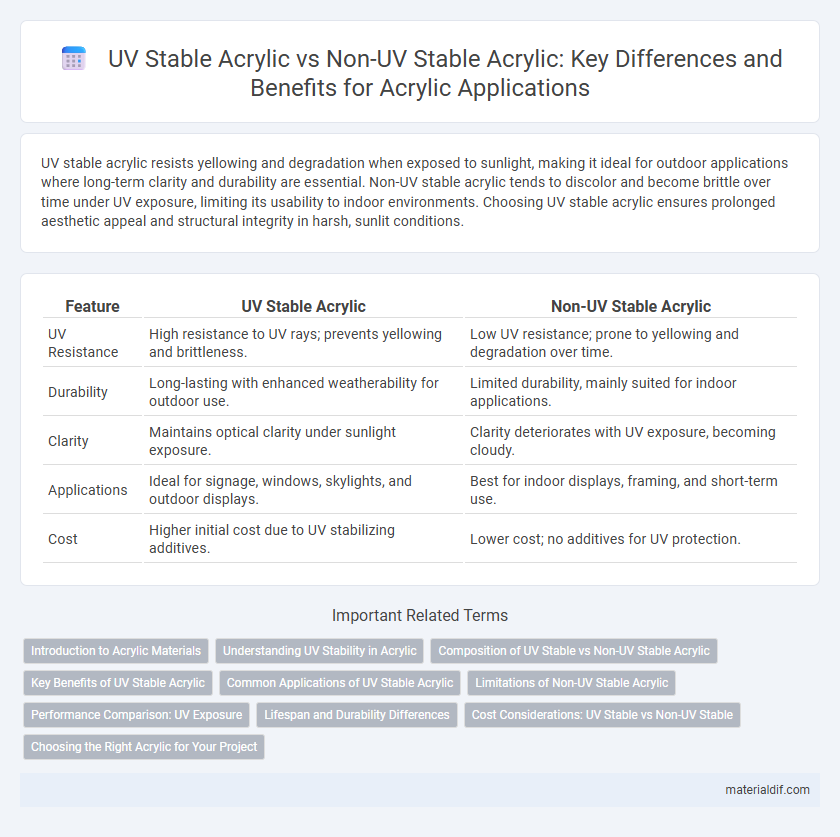UV stable acrylic resists yellowing and degradation when exposed to sunlight, making it ideal for outdoor applications where long-term clarity and durability are essential. Non-UV stable acrylic tends to discolor and become brittle over time under UV exposure, limiting its usability to indoor environments. Choosing UV stable acrylic ensures prolonged aesthetic appeal and structural integrity in harsh, sunlit conditions.
Table of Comparison
| Feature | UV Stable Acrylic | Non-UV Stable Acrylic |
|---|---|---|
| UV Resistance | High resistance to UV rays; prevents yellowing and brittleness. | Low UV resistance; prone to yellowing and degradation over time. |
| Durability | Long-lasting with enhanced weatherability for outdoor use. | Limited durability, mainly suited for indoor applications. |
| Clarity | Maintains optical clarity under sunlight exposure. | Clarity deteriorates with UV exposure, becoming cloudy. |
| Applications | Ideal for signage, windows, skylights, and outdoor displays. | Best for indoor displays, framing, and short-term use. |
| Cost | Higher initial cost due to UV stabilizing additives. | Lower cost; no additives for UV protection. |
Introduction to Acrylic Materials
UV stable acrylic features enhanced resistance to ultraviolet radiation, preventing yellowing and degradation over time, making it ideal for outdoor applications. Non-UV stable acrylic lacks this protection, leading to faster discoloration and brittleness when exposed to sunlight. The choice between UV stable and non-UV stable acrylic impacts durability, clarity, and longevity of products in environments with varying UV exposure.
Understanding UV Stability in Acrylic
UV stable acrylic contains special additives that prevent yellowing, cracking, and degradation when exposed to prolonged sunlight, ensuring long-lasting clarity and strength. Non-UV stable acrylic lacks these protective agents, making it prone to discoloration, brittleness, and surface damage over time. Understanding UV stability in acrylic is crucial for selecting materials in outdoor applications where exposure to ultraviolet radiation can compromise product performance and lifespan.
Composition of UV Stable vs Non-UV Stable Acrylic
UV stable acrylic contains additives such as UV absorbers and hindered amine light stabilizers (HALS) that protect the polymer chains from ultraviolet radiation, preventing yellowing and brittleness. Non-UV stable acrylic lacks these protective compounds, making it more susceptible to UV-induced degradation and discoloration over time. The presence of these stabilizing agents in UV stable acrylic enhances its longevity and clarity in outdoor applications.
Key Benefits of UV Stable Acrylic
UV stable acrylic offers superior resistance to yellowing and degradation when exposed to sunlight, ensuring long-lasting clarity and durability. Its enhanced UV protection reduces the risk of cracking and brittleness, making it ideal for outdoor applications such as signage, glazing, and display cases. This improved weatherability extends the lifespan and maintains the aesthetic quality of acrylic products in harsh environmental conditions.
Common Applications of UV Stable Acrylic
UV stable acrylic is extensively used in outdoor signage, skylights, and protective barriers due to its superior resistance to yellowing and degradation caused by UV exposure. Its durability makes it ideal for greenhouse panels and automotive components, where prolonged sunlight exposure is expected. Non-UV stable acrylic lacks this protection, leading to faster deterioration and reduced transparency in these environments.
Limitations of Non-UV Stable Acrylic
Non-UV stable acrylic suffers from rapid yellowing and brittleness when exposed to sunlight, significantly reducing its lifespan and optical clarity. Prolonged UV exposure causes polymer chain degradation, leading to cracks and surface crazing that compromise structural integrity. These limitations make non-UV stable acrylic unsuitable for outdoor applications where durability and transparency are critical.
Performance Comparison: UV Exposure
UV stable acrylic demonstrates superior resistance to discoloration, yellowing, and brittleness when exposed to prolonged ultraviolet radiation, maintaining clarity and structural integrity over time. Non-UV stable acrylic degrades faster under UV exposure, leading to surface cracking, reduced tensile strength, and compromised visual appeal. Performance under outdoor conditions highlights UV stable acrylic as the preferred choice for applications requiring durability and long-term aesthetic retention.
Lifespan and Durability Differences
UV stable acrylic resists yellowing and brittleness caused by prolonged sun exposure, extending its lifespan to over 15 years in outdoor applications. Non-UV stable acrylic tends to degrade faster, typically showing signs of discoloration and cracking within 2 to 5 years when exposed to UV rays. This difference in chemical stability significantly impacts durability, making UV stable acrylic the preferred choice for long-term, weather-exposed installations.
Cost Considerations: UV Stable vs Non-UV Stable
UV stable acrylic typically incurs higher initial costs due to specialized additives that enhance resistance to ultraviolet light, extending the material's lifespan in outdoor applications. Non-UV stable acrylic offers lower upfront expenses but may require more frequent replacement or maintenance because it degrades faster when exposed to sunlight. Budgeting decisions should weigh long-term durability and maintenance savings against initial price differences to determine the most cost-effective option.
Choosing the Right Acrylic for Your Project
UV stable acrylic offers superior resistance to yellowing and degradation when exposed to sunlight, making it ideal for outdoor or high-exposure projects. Non-UV stable acrylic is more cost-effective but tends to discolor and become brittle over time under UV light, suitable primarily for indoor applications. Selecting the right acrylic depends on balancing budget considerations with the required durability and environmental exposure of your project.
UV Stable Acrylic vs Non-UV Stable Acrylic Infographic

 materialdif.com
materialdif.com